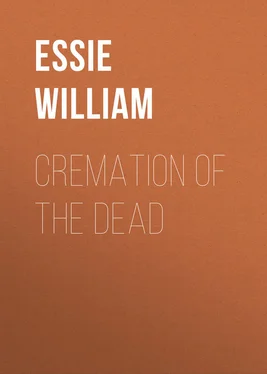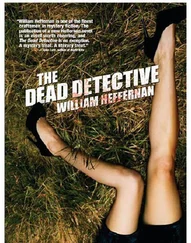William Essie - Cremation of the Dead
Здесь есть возможность читать онлайн «William Essie - Cremation of the Dead» — ознакомительный отрывок электронной книги совершенно бесплатно, а после прочтения отрывка купить полную версию. В некоторых случаях можно слушать аудио, скачать через торрент в формате fb2 и присутствует краткое содержание. Жанр: foreign_antique, foreign_prose, на английском языке. Описание произведения, (предисловие) а так же отзывы посетителей доступны на портале библиотеки ЛибКат.
- Название:Cremation of the Dead
- Автор:
- Жанр:
- Год:неизвестен
- ISBN:нет данных
- Рейтинг книги:4 / 5. Голосов: 1
-
Избранное:Добавить в избранное
- Отзывы:
-
Ваша оценка:
- 80
- 1
- 2
- 3
- 4
- 5
Cremation of the Dead: краткое содержание, описание и аннотация
Предлагаем к чтению аннотацию, описание, краткое содержание или предисловие (зависит от того, что написал сам автор книги «Cremation of the Dead»). Если вы не нашли необходимую информацию о книге — напишите в комментариях, мы постараемся отыскать её.
Cremation of the Dead — читать онлайн ознакомительный отрывок
Ниже представлен текст книги, разбитый по страницам. Система сохранения места последней прочитанной страницы, позволяет с удобством читать онлайн бесплатно книгу «Cremation of the Dead», без необходимости каждый раз заново искать на чём Вы остановились. Поставьте закладку, и сможете в любой момент перейти на страницу, на которой закончили чтение.
Интервал:
Закладка:
A method of petrifaction has lately been broached, and has met with some adherents. Something is to be produced similar to a relic which I once saw for sale in Manchester, taken from a guano-bed about thirty years ago, and which had been interred in the phosphates about a hundred and fifty years previously. In a cave in the Bay of Nipea, a number of bodies were discovered which had been petrified by the waters of some springs. The latest mode of effecting this kind of sanitary preservation was practised upon the body of Mazzini; and the result was, I understand, very disappointing.
A system of inhumation analogous to that practised when stone-coffins were in use is now agitating in Germany. 51 51 Dr. von Steinbeis.
It is proposed to encrust the subject over with a cement, and, after placing it in a sarcophagus of similar artificial material, to pour more of the same matter in a fluid state around it, so that the dead would be entombed in a solid matrix of long-enduring material. But those who are practically acquainted with the nature of cements, or rather with the impossibility of resting assured that proper cements would always be used, will know that it is more than likely that, out of the 32,000 who are said to die annually per million, one-half of the bodies would be enveloped in an impoverished material, which would speedily fall to pieces, with disastrous results. Dr. Sedgwick has expressed himself as certain that even plaster of Paris would prove ineffective in preventing the exhalations from coffins. Supposing, too, that each of the defunct required a space of one cubic yard only, where could cemeteries be obtained which could afford permanently to alienate 32,000 cubic yards of space per million annually? The scheme carries wildness upon its very face. Something analogous to this system of burial was the strange one carried out by the ancient Peruvians. A late traveller 52 52 Mr. H. J. Hutchinson.
has described some of the Huacas, as the places were called, and the well-preserved remains of which are still to be seen. It was a system of piling up coffins of plaster in pyramid fashion, to such an extent that one of these pyramidal mounds measures over 14½ millions of cubic feet. One carefully examined measured over 3½ millions of cubic feet, and was one mass of half-mummified bodies. As fast as a death took place, a chamber of sun-dried material was prepared upon the mound, and the body laid in it; and although the material of which the mound was composed was little else than mud-plaster, these cellular-built Huacas possessed a wonderful power of resistance to decay. One of them, in 1854, had occasion during the war to accommodate a battery of artillery on its summit.
Many of the ancient peoples buried in caves. The primeval races frequently used the caverns once inhabited by the extinct beasts for this purpose. 53 53 Buckland.
The ancient Persians hewed out holes in the mountains with the same view. The early Arabians also hid their dead in caves, in order to protect them from wild beasts. Burial-caves of some ancient Russian peoples are found along the Borysthenes. 54 54 Frazer.
To this class of burial might also be said to belong all those tombs which were built up in chambers with rude pieces of stone, and whether afterwards heaped over with earth or not. A tomb of this latter description was the huge barrow of the Emperor Yung-Lo, with its extensive megalithic avenue leading to its centre, by way of which the dead was visited or the tomb cleansed. 55 55 Lieut. Oliver.
The stone lines on Dartmoor may have originally belonged to this category. Even at the present day the Inguishes of the Caucasus bury in vaults of masonry built above ground, with an aperture in the west side by which the corpse is introduced, and which is afterwards filled up with stones. 56 56 Howarth.
We now approach burial in the earth , and the common practice of the present day. It is not needful, however, to say much here concerning it, as it will be treated of in a separate chapter, where its shortcomings will also be noted. The most persistent practisers of inhumation 57 57 This word conveys the meaning of burial in the actual earth better perhaps than any other.
are the Chinese. They seem rarely to have followed any other system of burial. Long before the Christian era they used coffins, and previous to committing them to the ground inserted in them gold and silver valuables. But at that time they did not form grave-mounds or fence them round with extensive palisades. 58 58 Wylie.
The secret of their attachment to burial in the earth lies in the fact that they believe that the body must rest comfortably in the grave, or misfortune will follow the family. 59 59 Dr. Eatwell.
The Chinese are therefore particularly anxious about the suitableness of the burial site, and sometimes a priest is consulted and a fresh interment made. This superstition has considerable disadvantages, because the dead not being interred in enclosed spaces, as with us, but at the fancy of the relatives, it is sometimes impossible to make roadways from place to place. They oppose tramways and railways for this reason, and riots with the Franks have already taken place in consequence. The Chinese never desecrate the graves of even foreign sailors, and have been known to inter cast-ashore bodies with the greatest attention. To wherever they themselves wander, and whether they die and are buried in California or in Australia, they are eventually re-interred in the Flowery Land, in the mortuary erections of the villages dear to them. It is therefore not uncommon to see a China-bound vessel from San Francisco well freighted with the bones of disinterred Celestials. On the hills in China the graves are often allowed to remain undisturbed for years, whilst in the low-lying districts the bones are gathered up as soon as possible. 60 60 Lockhart.
There is no such thing there as a burying-ground or cemetery.
The treatment of the dead known as embalming was carried on by the ancient Egyptians from apparently the remotest times. They believed in the transmigration of souls, and their return in three thousand years to the same body; hence the practice. Long before the sumptuous mummy-pits were commenced by the later races, the system was in full observance. There have lately been exhibited 61 61 By Mr. McCullum in 1873.
a bone necklace and two flint bracelets which were found in a very rude mummy-pit on the edge of the Plain of Thebes, and doubtless these represent the distant antiquity of Egypt. Flint instruments have also been found in mummy-cases. 62 62 Rossellini.
The extent of country over which mummifying must have extended was enormous, if, as is urged, 63 63 By Professor Gennarelli.
there was any kinship between the red races of Europe and America and the Egyptians – who all practised embalming in some shape or form – and as was supposed to be the case from the existence of pyramid building in all three countries.
Embalming has continued to meet with supporters in most civilised countries, but little practical result follows, for the opportunities of practising it are few and far between. Some literature exists on the subject, and a few treatises have been published upon it in our own country, notably one by Surgeon Greenhill in 1705. Mummifying preparations were, I find, patented by Orioli in 1859, by Morgan in 1863, by Audigier in 1864, and by Larnandes in 1866. Suggestions for a partial embalmment were also published in 1860 by Copping and in 1863 by Spicer. The filling of the arterial and vascular systems with concentrated solutions was also proposed by Spear, Scollay, and by two Parisians, in the year 1867; and yet another patent was issued in 1868. But we may assume that an universal system of embalmment is undesirable in our times. There is no purpose to serve in withholding from nature her very own. Cases may be imagined in which the practice would be advisable; but, as a rule, the earth's surface is required for the living, not for the dead; and we have, at least here, no underground caves. Had the Egyptians lived in a damp climate such as ours, there would have been no embalming. It is not every country that is suited to the practice. The people of Etruria were, it is now supposed, Egyptian in descent, but they were content with images of mummies only. The failures we ourselves have met with, and which are to be seen in the Royal College of Surgeons Museum 64 64 See the body of Mrs. Van Butchell, embalmed by Dr. Hunter and Mr. Carpenter in 1775.
and other places, are quite sufficient to disenchant anyone. The Egyptian authorities themselves eventually abolished the practice. 65 65 Walker.
What would they have said if they had lived to see their revered dead and their sacred animals carted away and sold as a drug, or worse still, as a manure? Professor Coletti has wisely remarked that when a man passes over to the majority 66 66 What a majority this must be, if the human skeleton from the Florida Reef is rightly estimated by Agassiz at 10,000 years old, the Egyptian relics from the Limant Bay borings by Rosière at 30,000, the remains from the New Orleans forest by Dowler at 50,000 years, and if the human bones found at the Illinois river, at Natchez, at Calaveras, at Anguilla Island, and in the Ashley river, are correctly stated by Schmidt, Dickeson, Whitney, Rijgersma, Holmes, Lubbock, and others, as contemporaneous with the mammoth and mastodon!
he should speedily become 'a handful of simple earth and nothing more.'
Интервал:
Закладка:
Похожие книги на «Cremation of the Dead»
Представляем Вашему вниманию похожие книги на «Cremation of the Dead» списком для выбора. Мы отобрали схожую по названию и смыслу литературу в надежде предоставить читателям больше вариантов отыскать новые, интересные, ещё непрочитанные произведения.
Обсуждение, отзывы о книге «Cremation of the Dead» и просто собственные мнения читателей. Оставьте ваши комментарии, напишите, что Вы думаете о произведении, его смысле или главных героях. Укажите что конкретно понравилось, а что нет, и почему Вы так считаете.












